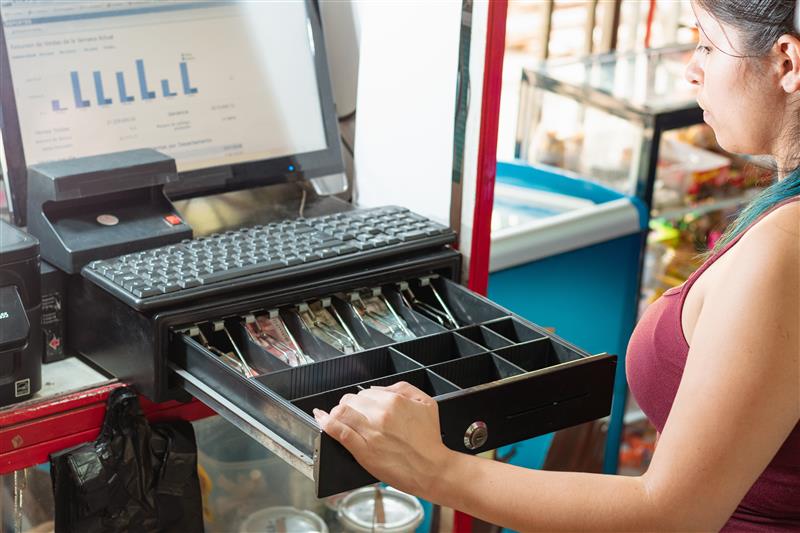This blog was first published in May 2023 and has been updated for accuracy on June 17, 2025.
Today’s consumers increasingly favor cashless payment options like credit and debit cards, as well as digital services such as Venmo, Zelle, PayPal, and Apple Pay. However, despite this trend, a portion of shoppers still prefer using cash. These cash transactions continue to create challenges for retailers, especially when it comes to managing cash register discrepancies like overages and shortages.
What are cash register discrepancies?
Cash register discrepancies occur when the actual cash in a register does not match the expected amount based on transaction records. These inconsistencies can stem from multiple sources, such as human error, technical glitches, or deliberate theft, which pose significant risks to retail operations.
Beyond immediate financial losses, cash discrepancies can disrupt daily workflows, damage customer trust, and obscure visibility into cash management.
Manual cash register reconciliation is often tedious and prone to mistakes, making it challenging to pinpoint the root causes of these errors.
Identifying, addressing, and preventing cash register discrepancies is essential for maintaining accurate financial records, ensuring compliance, and safeguarding against theft or fraud.
Common causes of cash register discrepancies
1. Human errors in cash handling
The majority of cash register discrepancies stem from simple human errors and insufficient cashier training rather than intentional fraud. For instance, a cashier might mistakenly enter the wrong amount into the register (such as inputting $20 instead of $10). This leads the system to calculate and display an incorrect change amount, which the cashier may hand over without double-checking.
Another frequent issue occurs when higher-denomination bills, like $20s, are misfiled in the cash drawer’s $10 section. This can cause overpayments and confusion during reconciliation. Without proper training and procedural checks, these honest errors can accumulate and contribute to cash register discrepancies.
Identifying the specific reasons behind cash over/short issues can be challenging, but proactive cashier training and clear cash-handling protocols are essential first steps toward reducing these common discrepancies.
2. Employee fraud and cash register theft
Employee fraud is a major contributor to cash register discrepancies. This occurs when an employee steals directly from the register or collaborates with an accomplice to commit theft. According to Retail Dive, “employee theft constitutes a substantial portion of retail losses. In 2022, it accounted for 29% of retail shrinkage, with external theft at 36%.”
According to the California Restaurant Association, “75% of employees admit to stealing from their employer at least once during their employment.” Motivations include financial hardship, greed, or a sense of entitlement. When employees see others getting away with theft or perceive a low risk of being caught, they may be more inclined to steal.
Some employees are coerced by acquaintances or family members to commit fraud, especially in stores with minimal oversight. Theft methods range from pocketing cash from the till, under-ringing sales and pocketing the difference, or giving excess change to a partner. Managers responsible for replenishing or removing cash from registers can also exploit these moments to steal funds.
3. Cash register system failures and external threats
External factors beyond the cashier’s control can also cause cash register discrepancies. For example, a shortage might result from a manager’s error when filling the till, or, in more serious cases, intentional theft by a manager seeking to shift blame onto the cashier.
Discrepancies may also occur if a cashier from a previous shift steals money, leaving the till short. Quick-change artists pose another threat, using deception to confuse cashiers and walk away with extra cash. For instance, a customer might pay for a small item with a large bill, then rapidly request multiple change transactions, talking quickly to distract the cashier. The goal is to create confusion, so the cashier loses track of the original transaction and inadvertently hands over more cash than they should.

3 Best practices for preventing cash register discrepancies
Identifying the root cause of cash drawer discrepancies can be challenging, especially in environments where multiple cashiers share tills, and reconciliation is infrequent. However, implementing the following best practices can significantly reduce errors and fraud:
- Implement Regular Cash Drawer Audits: Shared tills and infrequent reconciliations increase the risk of discrepancies going unnoticed. To mitigate this, conduct daily or shift-based cash drawer audits. This practice ensures variances are identified promptly, reducing the number of cashiers who could be responsible, and providing a clearer audit trail for investigation.
- Train Staff on Proper Cash Handling Techniques: Comprehensive training is essential to minimize human error and deter fraud. Equip cashiers with clear procedures for entering transactions, giving correct change, and verifying high-denomination bills. Reinforce the importance of double-checking transactions and maintaining vigilance against quick-change scams and customer distractions.
- Use Technology for Cash Management: Manual tracking and reconciliation are inefficient and prone to errors.
The answer to preventing cash register discrepancies lies in technology.
Implement advanced cash management solutions that automate cash tracking, flag discrepancies in real-time, and provide detailed reports. These technologies can identify patterns of loss, reduce the risk of undetected theft, and help managers focus on high-priority variances.
Technology for cash register discrepancies and reconciliation
Appriss® Secure Cash Over/Short empowers retailers to improve cash management, reduce errors, and strengthen fraud detection efforts. This robust solution enables proactive cashier and register monitoring, making it easier to detect and resolve cash discrepancies before they escalate into larger financial risks.
With real-time insights into discrepancies, trends, and high-risk behaviors, you can quickly identify issues, take corrective action, and protect profits.
Cash Over/Short offers a comprehensive solution to the challenges faced by retailers in managing cash drawer overages and shortages:
- Automates cash reconciliation, eliminating manual tracking for accurate cash handling.
- Proactively monitors cashier activity, enhancing accountability, and preventing internal cash loss.
- Provides comprehensive data analysis capabilities to identify trends and investigate discrepancies.
- Integrates with Secure Search to strengthen fraud detection efforts.
- Offers actionable insights to optimize cash management processes.
- Saves time and enhances loss prevention efforts.
- Protects the retailer’s bottom line.
- Drives operational efficiency in cash handling.
Safeguard your profits with real-time cash management
Cash register discrepancies (whether due to errors or fraud) can erode profits and damage employee trust. The longer these discrepancies go unnoticed, the greater the risk of financial loss. Routine cashier oversight is essential, but relying on manual reviews leaves too many gaps.
By adopting a real-time, technology-driven solution, retailers can swiftly identify and address overages and shortages, protect their bottom line, and foster a culture of accountability.
Stay proactive. Embrace the tools that help you catch discrepancies before they turn into major issues. Download the Secure Cash Over/Short Solution Overview to discover how to take control of cash management and safeguard your bottom line.





